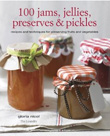RHUBARB FOR SALE
Friday May 21st 2010, 8:32 pm
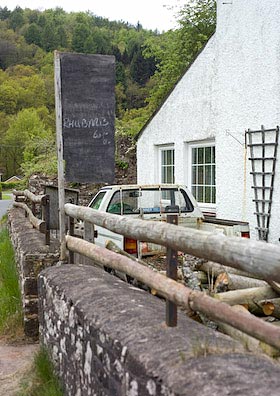
Month five Tigress’s can jam canning challenge and for May there are two ingredients to choose from; asparagus and rhubarb. Asparagus is still quite hard to come by locally. I found some in the Co-op but as it has come all the way from Peru I decided to give it a miss. I have a hard and fast rule to only buy English asparagus, which therefore means I only buy it during the 6-8 weeks that it is in season. I did buy an organic bundle in the deli here at Taurus Crafts, where my shop is situated, but it was quite expensive, so there was no way I would be prepared to mess about with such a prized ingredient other than to devour it chargrilled for my supper. So that leaves rhubarb, a crop I have already been working with for the last two and a half months but that is such a favourite of mine that I have yet to tire of it.
As luck will have it, whilst driving through the Forest of Dean I happened upon someone selling rhubarb at a very reasonable price from his smallholding. This place is a real find and I know that I will go back there often from now on, as he grows a great selection of soft fruits which will be really useful for preserving as the summer unfolds. I stupidly didn’t ask the man’s name, but will be sure too on my next visit. When I parked up and knocked on his door, my rhubarb was yet to be picked, so I knew it was as fresh as could be when the generous bundle was handed to me for a snip. Rhubarb is a strange crop. It grows really easily and can be seen in abundance in local allotments and gardens, but it is hard to find for sale and supermarkets rarely sell it. Tesco stock it most of the time but don’t always source British never mind locally. I saw it for sale earlier in the year shipped from New Zealand, which seems extraordinary when there are varieties in the UK which can grow almost all year round. So as I drove back home, with my canjam ingredient on the seat beside me, what was left to decide was what to make next.

I have already made a rhubarb marmalade, a rhubarb jam and a rhubarb cordial this year, so in the quest for something different I have decided to opt this time for a ketchup. Chutneys, sauces, relishes and ketchups are all kind of similar, except that they vary in texture and consistency. I fancied a ketchup that was smooth, with no recognisable pieces or chunks. I thought that if I kept the ingredients pale; white sugar, golden sultanas etc, I might just get away with a pinkish looking result. It wasn’t to be, as it cooked down it did take on a pinkish hue but of a beige variety. At that point I had to decide whether to stick with boring unattractive beige or whether to make the colour deeper and richer. I opted for the latter and added some balsamic vinegar. This has only a slight impact on the eventual taste of the ketchup so may seem a rather superficial consideration, but for me the downside of my ketchup is that what I have ended up with is brown. Brown, brown, brown. One of the most wonderful qualities rhubarb posesses is its colour. What a blunder, I should have made a beautiful clear rhubarb jelly instead to add to my already groaning rhubarb preserve mountain. However, now I’ve come to terms with the lack lustre appearance, the taste is making up for it. A sort of wolf in sheeps clothing scenario. I’m beginning to fantasise about dolloping ketchup on bubble and squeak, as a relish on a Double Gloucester sandwich or even with yoghurt and extra virgin rapeseed oil to dress some homegrown salad leaves. It may be brown but it is a winner all the same.
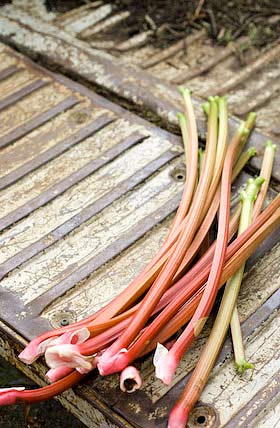
A while back I had an email from someone in the US who had bought my book. She said she was going to return the book to the shop the following day, accusing me of being ‘cavalier with ginger’. Amongst my friends, since then, this phrase has often been repeated and never fails to give us a laugh. My rhubarb ketchup is unashamedly cavalier with ginger, as rhubarb and ginger make such fine bed fellows. Obviously, if you aren’t a ginger fan, then tone it down to suit your taste. As usual when making chutneys, relishes and ketchups, that all contain vinegar, they do need a maturing phase to mellow the sharpness. This ketchup is surprisingly tasty straight away as I added some honey at the end which just takes the top edge off any harshness, but if you leave it for 3-6 weeks before opening you will find it well worth the wait. The result is fruity, spicy and I’m convinced it will be very versatile. I am not sure whether a strong enough ‘rhubarb’ vibe comes through yet, more of a lovely but general ‘fruity’ one, but I’ll see what it is like in a month or two and report back then. It is certainly worth making if you have rhubarb to spare that you hate to waste.
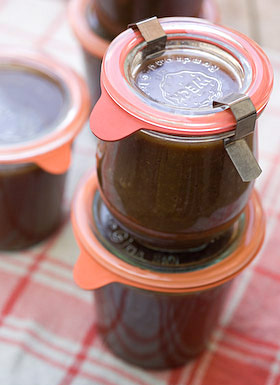
CAVALIER GINGER AND RHUBARB KETCHUP
Makes approx 1.6Kg (3 1/2 lbs)
1Kg (2lbs) chopped rhubarb
300g (10oz) onion (approx 3 med onions), chopped
325g (12oz) white sugar
1 Tbsp sea salt
600ml (1 pt) white wine vinegar
80ml (1/2 cup) balsamic vinegar
300g (10oz) raisins or sultanas
4 garlic cloves (approx 10g) peeled
4 knobs of ginger (approx 30g) peeled
2 tsp mustard seed
1 tsp allspice, ground
1tsp ground coriander
2 small dried chillis, crumbled
1/4 tsp cinnamon, ground
1/4 tsp cloves, ground
1 Tbsp honey
Place the rhubarb, onions sugar and sea salt in a non reactive preserving pan. Place the garlic, ginger, raisins (or sultanas) and vinegar in a food processor and pulse it to roughly chop everything together and break up the dried fruit. Add to the preserving pan along with the ground spices. Place the whole spices in a pestle and mortar and crush them roughly, then tip them into a piece of butter muslin, tie up in a parcel with string to secure and add to the pan.
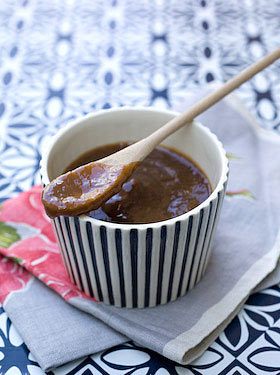
Bring to a simmer and cook until the fruit is soft, the onions are transparent and the consistency is beginning to thicken. Remove the spice bundle and push the contents of the pan through a sieve or use a food mill with a fine mesh, collecting the resulting smooth mixture. (This part of the job took rather longer than I’d have liked. Next time I will probably wizz the mixture in a blender or food processor first so it passes through the sieve faster.) Return to the pan.
Prepare the water bath, jars and seals ready for canning. For more info about how to hot water process, refer to the guide here. Add the honey to the mixture and stir. Bring the contents of the pan to a simmer and cook further if necessary until the ketchup is of a suitable consistency, like tomato ketchup. Pour into the jars leaving required headroom, seal and hot water process for 10 minutes. Remove the jars from the water bath and leave them till completely cold before testing the seals. Label and store. Leave the ketchup for at least 3 weeks before using. Without water processing the ketchup will still keep for several months unopened.
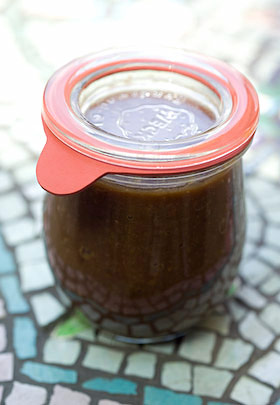
RHUBARB AND ANGELICA CORDIALIZED
Friday April 23rd 2010, 1:54 pm
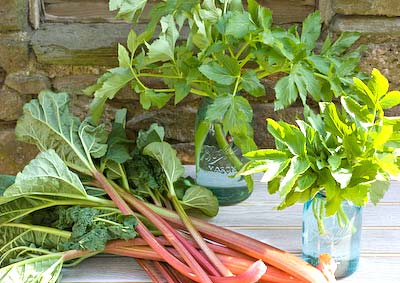
Month four Tigress’s can jam canning challenge and the chosen ingredient is herbs. This is a funny one, as herbs are a flavouring and sidekick rather than a main player ingredient so thinking cap required. Ingredient wise, this is where everybody needs good neighbours. Helen and Steve a few doors one side have a thriving patch of rhubarb but noone in the house enjoys rhubarb enough to make use of it. As explained in my last post (just yesterday) Jane’s garden, a few doors down on the other side, has angelica growing so can provide the herbal element needed to meet the can jam criteria. So both my ingredients couldn’t be more local, more seasonal or more freely available. Angelica can be used to offset the tartness of fruits such as currants, gooseberries and rhubarb so it is an ideal pairing.
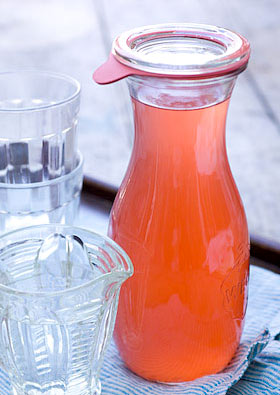
With the sun at last making an appearance and the need to get to grips with horticultural tasks, naturally my thoughts have turned to the need for cordial as a suitable refreshment whilst I work. I started looking for inspiration and found it in Fancy Pantry by Helen Witty. I’m liking the look and feel of this book, published in the US in 1986, found a while ago on Amazon. It is full of recipes for stocking your pantry, including some preserves, pickles and relishes, and for me, someone in the UK not so familiar with canning, it includes reassuring processing information where relevant. Since it arrived in the post I have spent many hours enjoying this book and there in the ‘sippin’ substances’ chapter a recipe for rhubarb nectar caught my eye and seemed a good starting point for my April Can Jam project. Cordials are really easy to make, like the first process of jelly making without the worry of achieving a set at the end.
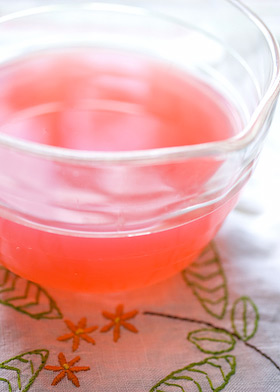
I am really pleased with the result. I used the angelica leaves and at my first attempt layered them with the rhubarb to let the flavours infuse. I didn’t feel that the angelica made its presence felt strongly enough so have devised another method to make an angelica syrup which is then added to the rhubarb. I’m going to be making lots more of this cordial, with and without the herbal note, as the resulting drink is supremely versatile and quite delicious. Simply serve as a refreshing drink diluted with still or fizzy water or as part of a more grown up cocktail, such as a pink gin fizz, made by mixing equal measures with gin over ice and topped up with soda and a sprig of mint. There is plenty of room for experimentation, you just have to watch that nothing you add overpowers the exquisite rhubarb flavour. The cordial is also a fabulous colour.
RHUBARB AND ANGELICA CORDIAL
Makes approx 1.7 litres (3 pints)
100g (3 1/2 oz) angelica fresh leaves
450g (1 lb) caster sugar
2kg (4 lbs) rhubarb
1.2ltrs (2 pints) water
Wash and drain the angelica and shake dry, then chop roughly and place in a dish in layers with half of the sugar sprinkled in between and over top to cover. Leave for 24 hours until the sugar has turned to syrup. Put into a pan and heat gently, stirring to be sure all the sugar has dissolved. Bring to the boil then remove from the heat, pour back in the dish and leave overnight. Return to the pan, bring to a simmer and cook gently until the leaves begin to look transparent, which should only take 5 minutes or so. Pour through a sieve to leave a clear syrup. This method should extract as much of the angelica flavour as possible. Cut the macerating time down as required if you are in a hurry.
Wash and drain the rhubarb, removing leaves and trimming the ends. Cut thicker stalks in half down the middle then chop into 1cm sized pieces. Place in a pan with the water, bring to the boil and simmer gently for 10 – 15 minutes until cooked through. Pour into a suspended jelly bag and leave overnight to drip through, catching the juice in a jug.
Prepare the canning bath and sterilised bottles. Place the rhubarb juice, angelica syrup and remaining sugar in a pan and heat gently, stirring all the time until the sugar is dissolved. Bring to the boil then remove from the heat, pour into your hot bottles, leaving the required headroom for your bottle type (mine shown in the picture looks like it has a bit too much headroom! I’ll do better next time) seal and process for 10 minutes. Leave till cold and label. For more info about how to hot water process, refer to the guide here.
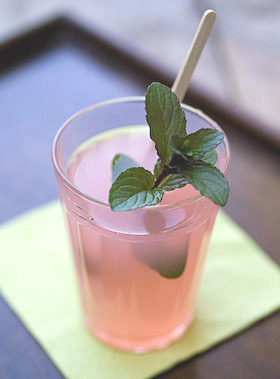
After candying the small quantity of angelica stems I had and using some of the leaves to make my rhubarb and angelica cordial, I still had some leaves left over. Hating the thought of wasting them I decided to make a second cordial. As the intention was to ‘can’ the cordial and I was worried whether it would be acidic enough to safely do this way, it seemed like a good idea to make it following a similar method you might use when making elderflower cordial. For this you include some lemon juice as well as a small amount of citric acid to help its keeping qualities. I have a stock of citric acid, bought a while back at my local chemist. I know some people find it difficult to get hold of but it can be found at home brew shops and on ebay as well if your pharmacy is unable to supply.
I wasn’t at first sure whether the lemon and citric acid rather overpowered the more subtle angelica flavour but I’ve just drunk a glass diluted down with sparkling mineral water and the flavour came through in a lovely distinctive way which sets it apart from the elderflower version.
ANGELICA CORDIAL
Makes approx 1.7 litres (3 pints)
1.2 litres (2 pts) water
900g (1 lb) caster sugar
200g (8 oz) angelica leaves, chopped
3 tsp citric acid
juice and zest of 2 lemons
Make a sugar syrup with the sugar and water by heating them together in a pan, stirring until all the sugar is dissolved and bringing to the boil. Remove from heat and add the citric acid. Put the angelica, lemon juice and zest in a bowl and pour the syrup over them. Cover the bowl and leave for 24 hours to macerate and infuse.
Strain through muslin and collect the liquid in a pan. If you are planning to can the cordial so it can be stored, prepare the canning bath and sterilise the bottles. Bring the cordial just to the boil then remove from the heat, pour into your hot bottles, leaving the required headroom for your bottle type, seal and process for 10 minutes. Remove from water bath and leave till cold then label. For more info about how to hot water process, refer to the guide here. This cordial will keep for several weeks unprocessed in the fridge but will store for up to a year unopened after processing.
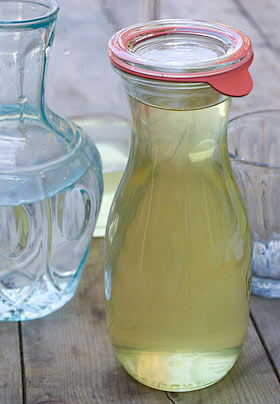
AN OBSESSION WITH ANGELICA
Thursday April 22nd 2010, 6:12 pm
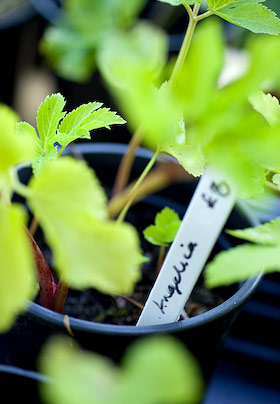
I first came across angelica, the herb, when I looked round my neighbours garden a few years ago. Jane and Les Hales’s garden is very special, so special in fact that it is open to the public a couple of days a year as part of the National Garden Scheme. Jane has planted angelica in several parts of the garden and uses this tall stately plant to form screens against the house. I was instantly impressed by the plants towering stature and amazing flowerheads that look so graphic and beautiful against blue sky.
Jane usually has a few seedlings for sale at her open days. Apparently once you manage to get angelica to grow, this biennial seeds itself freely, so restocking the plant is not an issue. I have tried growing it since then. The first two years, our wet summers encouraged the slugs to decimate my young plants, so even my best efforts came to nothing. This year is looking slightly brighter, and I already have a plant doing well on my allotment and a few more small seedlings that I am cherishing a little longer before planting them out to fend for themselves.
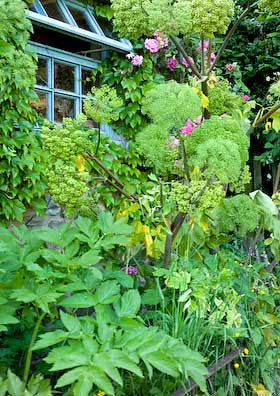
I had a vague recollection of candied angelica from my childhood, a strikingly vibrant green confectionery used to decorate trifles, a small strip pushed into the cream top layer either side of a bright red glace cherry, and can just about recall it having a rather exquisite and unusual flavour, but that was as far as my knowledge went. I certainly had no inkling that it came from a herbal or vegetable source. This of course set me off on a quest to find out more about the culinary merit of this impressive herb and I vowed to have a go at candying my own angelica to try and rediscover the distinctive flavour remembered as a kid.
All parts of the plant are aromatic and edible. The stems are the bits you candy to make confectionery, the leaves are used for flavouring many liqueurs such as chartreuse as well as in the preparation of bitters, and with juniper berries to flavour gin, the root is blended with wormwood and other herbs to make absinthe and the seeds impart a muscat-like flavour to wine and are used in the preparation of vermouth. All impressive stuff.
Stems for candying or crystallizing need to be young. It is no good waiting too long to harvest them as by June – July time they will be far too stringy and tough to work with. You will know by now that being prepared well enough ahead is not my strongest point, but this year, for once, no doubt prompted by Tigress’s can jam canning challenge I am taking part in, which has chosen herbs for our April ingredient, I have gotten round to acquiring a handful of stems and a nice bunch of leaves from Jane which she very kindly cut for me. The plan, to use angelica as my canjam ingredient (post to follow this one), but also to candy some stems at the same time.
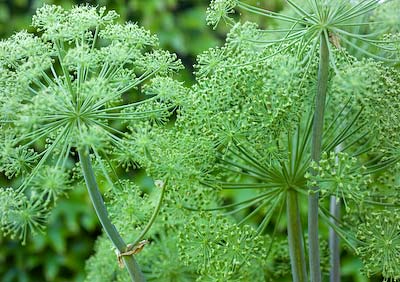
What is interesting is the point at which the angelica turns from a herby savoury scent and flavour to a sweet unctious syrupy one. The stems need first to be boiled and scraped, which is a bit fiddly, before layering them with sugar to begin the transformation. As I had very few stems to play with, I used some of the thicker leaf stalks as well. Apart from the peeling process, it was merely a matter of 5 or 10 minutes of activity followed by a day or so of leaving well alone, so it is hardly taxing. As soon as a syrup started to form, the angelica took on the magical taste I remembered and I felt as though I had captured the essence of this wonderous herb. It is worth having a go, even if you only candy angelica once in your life. The basic recipe I followed comes from Bee Nilson’s Herb Cookery, published in 1974. She is one of my favourite cookery writers for allsorts of reasons. Scale the recipe down if you don’t have enough stems.
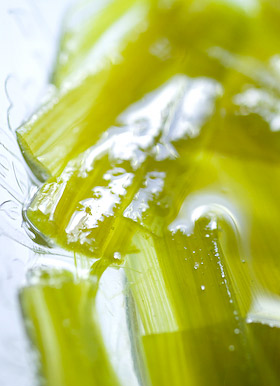
HOW TO CRYSTALLIZE ANGELICA
1/2kg (1lb) angelica stems
Wash the stems and cut into 8-15cm (3-6in) lengths. Boil them in enough water to cover until the stems are tender. For young stems this should only take about 10 minutes. Drain well, rinse with cold water and drain again. Scrape the outer skin from each piece. I found it easiest to slit down the side of each hollow tub and lay them flat on the surface. The skin comes off really easily but you need a lightness of touch so what remains isn’t damaged. Place them in a shallow dish.
1/2kg (1lb) caster sugar
Sprinkle the sugar evenly over the stems. Cover the dish and leave it for 2 days by which time the sugar will have dissolved and become syrupy.
250ml (1/2pt) water
Put the angelica, sugar syrup and water in a pan and heat whilst stirring until the syrup boils. Simmer gently until nearly all the syrup is absorbed and the angelica is clear. Add more water if the syrup has all gone but the stems aren’t looking transparent. Drain the angelica and leave till cool enough to handle, then roll them in more caster sugar to coat them generously. Spread the pieces on a wire cooling rack and finish drying them in a warm place or a very cool oven. When cold wrap the angelica in waxed paper to store.
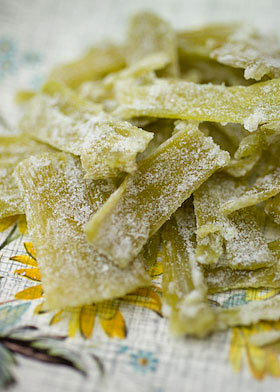
This year, Ramblers, Jane and Les Hale’s garden at Aylburton Common in the Forest of Dean, is open as part of the National Garden Scheme on two Sundays; 2nd May and 13th June 2-6 pm, and also by special appointment during May and June only. You can find more information on the National Garden Scheme website here.

THE MARVELLOUS MS MARMITE-TEE-EE
Tuesday March 30th 2010, 4:29 pm
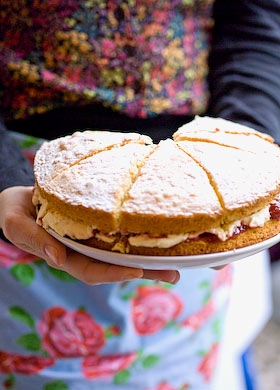
For me, running a business has at times felt disappointing. Obstacles seem designed to get in the way of creative thinking, and it takes training and experience to restore your enthusiasm and energy at times. Creative ideas are what fuel and excite me. The days of setting up a stall of your wares down the Kings Road, just because you could, are long gone. Spitalfields used to have that excitement for me too, but once the potential is spotted, big business takes over and the cost of shop leases goes through the roof. The many shows where individual makers can sell their wares, end up costing an arm and a leg to take part and you really have to know what you are doing to turn them to your advantage and make them pay. Unless you’re dead smart, most of ones business life can be coined by the phrase ‘putting it down to experience’. But what joy, the spirit of entrepreneurial adventure lives and this weekend I’ve seen it with my own eyes.
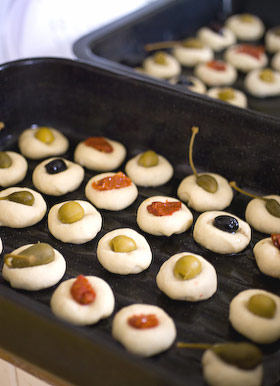
This Sunday the first underground farmers and craft market was held in secret in Kilburn, north west London. I say secret, because as an underground event it was operating outside the conventional ways of doing these things. Thirty-odd businesses, artisan makers, keen amateurs and a couple of friends who thought it might just be fun to do some baking, put our their wares in any space available in an ‘ordinary’ one bedroom flat with garden, summerhouse and balcony, the abode of the marvellous ms marmite lover. MsMarmitelover, has for some time now been causing a stir with her underground restaurant, holding special suppers in her home, attendance by ticket only. She is most definitely a trail blazer with a streak of anarchy. I have been following her on Twitter for some time now and when she tweeted to say she was hoping to hold a farmers and craft market in her sitting room, might anyone be interested to take part, I was there like a shot.
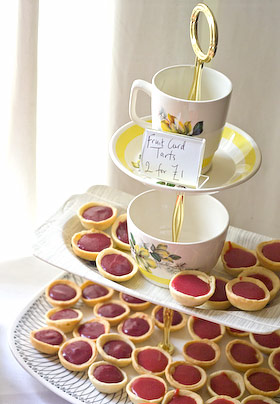
As a person who needs a deadline, it was a good reason to make me sort out some packaging for my jams, marmalades and fruit curds, at the same time without it being too big a deal. I made raspberry and blackberry curds using some frozen fruits grown organically here at Taurus Crafts and using eggs from my neighbour Jane Hale’s hens, that were as fresh as fresh can be. If I say so myself, they are pretty damn fab. I served up tasters in tiny pastry cases, tweeny weeny curd tarts stacked on my homemade wacky cake stand. I also made 2 marmalades; bitter seville marmalade and my special pink grapefruit, rhubarb and cardamon marmalade as well as a jam that went down a treat; rhubarb, blueberry and lime jam.
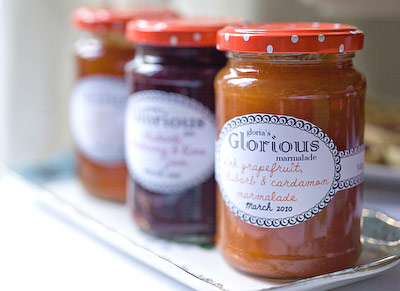
Back to the market, in the house, every inch of space was utilised to its best. Someone created a cocktail bar on the ironing board, the mantel shelf was used to display cupcakes, my jam jars were lined up along the top of the upright piano and the bed was strewn with wonderful baked goods and crocheted flowers. Occasional tables became shop fronts for chutneys, cup cakes, more cup cakes, sauerkraut, chocolate brownies, all the foodstuffs you could ever dream of, and a steady stream of enthusiastic customers wandered through, tasting and sampling as they went. There were wacky tourettes biscuits embossed with rude words, cupcakes in handmade flowery boxes and bundles of napkins made of 50’s inspired fabrics. It was utterly totally lovely.
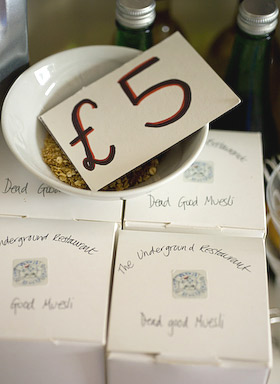
There were cookery demonstrations taking part in the kitchen; how to make your own hollumi cheese, Ms Marmite made her very own focaccio shots, that were delicious, Porridge lady made porridge the proper way using organic oatmeal and a lot of stirring. The atmosphere was buzzing and others taking part were a friendly bunch. I only wish I had had more time to enjoy the event as a customer. This will no doubt be the start of a new craze. Whether or not such energy can be recreated remains to be seen, but I’m up for it.
To be kept up to date on MsMarmite Lovers events you can find her blog here.
To see more of my pictures from the day look here and even more here. Feature in the London Evening Standard here.
Apologies for not naming all the participants photographed or taking pictures of everyone who took part, I had too much on my plate to record all that information.
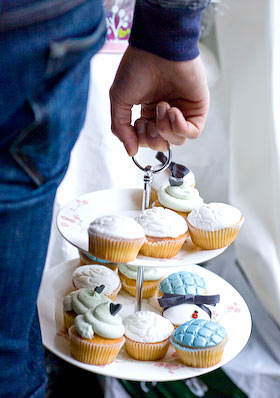
ONIONS WITHOUT TEARS
Thursday March 18th 2010, 12:11 am
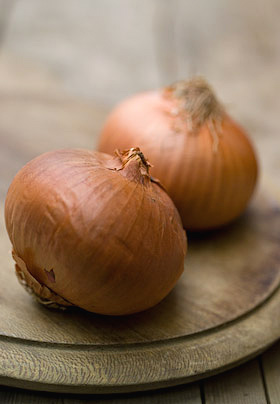
Month three Tigress’s can jam canning challenge and the chosen ingredient covers a multitude of choices, as anything classed as an allium fits the bill. I intended to post about pickled wild garlic but with the deadline looming and this post ready to roll, I’m running with pickled onions instead. The wild garlic, almost completed, will follow after.
I’m really more of a jam and chutney person but the Tigresscanjam challenge is giving me reasons to explore things I want to know more about. Pickles aren’t something I’ve developed much of a taste for and I hadn’t thought that they figured much in my upbringing. Then I remembered an onion and vinegar condiment, served at my grandparents house when I was little, as an accompaniment to Lancashire hotpot. It was made very simply of chopped raw onions marinated in malt vinegar, simple as. Never a great meat eater, I recall especially looking forward to this onion relish, eaten with the delicious sliced potatoes that were part of the hotpot.
My cousin Jackie, an ex-Blackpool landlady who can rustle up a mean Lancashire hotpot, told me that this onion relish is the traditional companion to this regional speciality along with pickled red cabbage. Though I have no recollection of ever being served pickled cabbage as a kid, knowing this makes me pleased that pickling is part of my own heritage too, something I’d managed to forget about until the canjam challenge got me thinking. Then last week I found this onion-shaped Weck preserving jar in a charity shop, so filling it with pickled onions seemed perfectly appropriate.
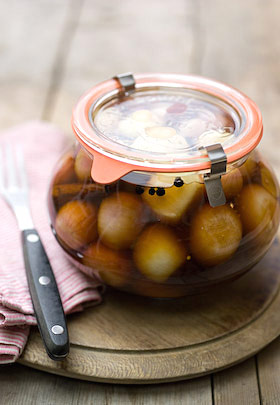
Pickling has to be one of the easiest things ever. I’ve chosen to make a sweet pickling vinegar using traditional malt vinegar with added brown sugar, honey plus a few spices. Pickling vinegars are really delicious and give plenty of scope for experimentation. Any leftover vinegar can be turned into salad dressings or be drizzled on your chips. The shallots need to be salted at the beginning to draw out excess liquid, which will help the onions to retain their crunch. I have hot water processed my jar of pickles to meet the criteria of the challenge, give myself more practice at canning and to use the jar in the way it was intended, but pickled onions are a pretty safe bet without that palaver. The processing makes them extra safe.
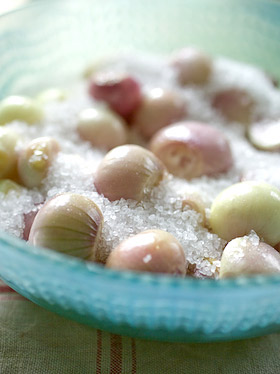
SWEET PICKLED ONIONS
Fills a litre (quart) sized jar
750g (1 1/2lbs) shallots
50g (2oz) salt
.5ltr (1pint) malt vinegar
100g (4oz) soft brown sugar
100g (4oz) honey
1 tsp peppercorns
1 dried red chilli
1/2 tsp mustard seeds
5cm (2in) piece of cinnamon stick
2cm (1in) cube of fresh ginger sliced
Pour boiling water over the shallots, leave them for a few minutes, then drain and rinse with cold water. Remove the skins and place in a glass bowl, sprinkling the salt in layers over them. Leave overnight, then rinse and drain them before packing into the hot sterilised jar.
Place the vinegar and the remaining ingredients in a pan, stir over a medium heat to dissolve the sugar and honey, then bring to the boil. Pour over the onions to cover, pushing the chilli and cinnamon stick between the shallots on the outside of the jar, leaving 1 – 2cm (1/2 – 3/4in) headspace. Seal with the lid and process for 15 minutes in a hot water bath. For more info about how to hot water process, refer to the guide here. You could use 2 500ml (1 pint) sized jars instead, in which case you only need to process them for 10 minutes. Once cooled store the pickled onions for 4-8 weeks before eating.
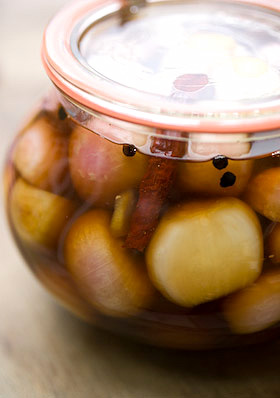
AND YOUR POINT IS….?
Friday February 19th 2010, 4:22 pm
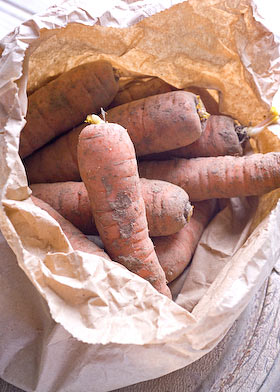
Month two, Tigress’s can jam canning challenge, and the ingredient to grapple with is ‘carrots’. They aren’t in season in the UK, not as a freshly pulled from the ground seasonal veg at any rate, otherwise I would have found some of those trendy purple ones to work with, or a nice bunch with their greenery attached that would have made a lovely picture tied in a bundle with garden twine. So a brown paper bagful of locally-grown and stored organic specimens is my starting point.
There is one good thing about it, I’ve learnt a lot since ‘carrots’ was announced. I wanted to find a recipe suitable for canning that needs carrots instead of just includes them, so I trawled through my extensive collection of books on preserving. I felt sure I would unearth a war time gem, thinking carrots would have been used more as a sweetener in times when sugar was scarce, but nothing turned up. I didn’t want to simply bottle carrots for the sake of it, couldn’t find a suitable pickle recipe, was about to adapt a Madhur Jaffrey recipe for quince and lemon chutney (by adding carrots) then forgot and cooked my last quinces. I was tempted by my trusted and much loved ‘Let’s Preserve It’ by Beryl Wood, a little jewel of a paperback from 1970 which contains 579! recipes, including a carrot chutney, a jam, 2 marmalades as well as a recipe for spiced carrots. but eventually settled on combining carrots with rhubarb in a jam.

British forced rhubarb is just starting to appear for sale. The season for forced rhubarb, grown in the ‘Yorkshire triangle’ begins January through to April, when field grown takes over. My head has been full of rhubarb all month as I am sorting out which varieties to plant on my allotment. Rhubarb alone is fantastic, so I just hoped that the inclusion of carrots in the recipe would be a wonderful addition rather than just meeting the canjam deadline. I’ve also added some chopped stem ginger and candied peel as I have some candied melon slices left over from baking at Christmas, so it has been a good opportunity to use some up. I recommend you use good quality candied peel for this, usually sold in chunky pieces from a deli or health food shop, rather than that ready chopped stuff in tubs surrounded by gloopy syrup you find in supermarkets.
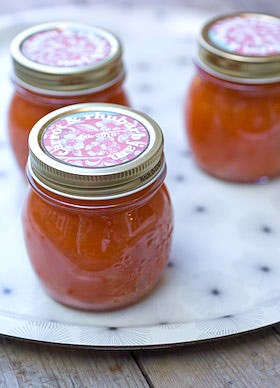
I did have to watch that the jam didn’t burn whilst I was boiling it to a set. As it cooked it turned to a beautiful deep orangy-red gelatinous consistency but it spat as it boiled. As both carrots and rhubarb are lacking in pectin, it is probably advisable to use jam sugar with pectin added or add extra pectin if you want a good set. I used half ordinary white sugar and half jam sugar, because I had some needed using up. What I have ended up with is quite a soft set but the taste is amazingly good. The recipe uses enough carrots to be ‘useful’ from the ‘using up a glut’ perspective and the jam isn’t overly sweet, so it makes perfect sense for canning. It would be ideal as a filling for jam tarts or Tigress’s thumbprint cookies or to fill a larger pastry case with the addition of an egg beaten into it then baked in the oven to set. A slice served with cream or mascarpone flavoured lightly with some ginger syrup from the stem ginger jar would work perfectly. All in all, it has been an unexpected success.
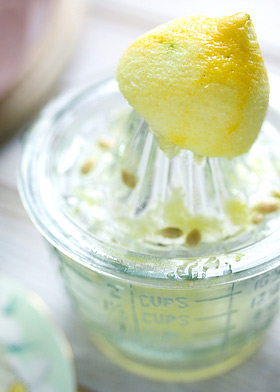
CARROT & RHUBARB JAM
Makes approx 1.5Kg (3lbs 5oz)
500g (1lb 2oz) carrots, peeled, topped and tailed
500g (1lb 2oz) rhubarb, washed and trimmed
1 unwaxed lemon
800g (1 3/4lbs) sugar (use jam sugar with added pectin for a stronger set)
60g (2oz) stem ginger (approx 4 balls)
150g (5oz) candied peel (any citrus or melon will do)
Finely grate the carrots and place in a pan with 500ml (3/4pt) of water. Finely grate the zest from the lemon, squeeze out the juice and place to one side. Chop the lemon halves, pith and all, into chunks and place them and any pips in a muslin bag tied closed with string or a knot and add them to the carrots. Bring to a simmer and cook with the lid on for 20 minutes, then remove from the heat.
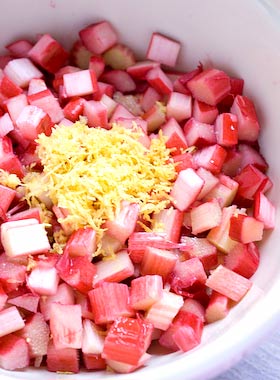
Chop the rhubarb into 1cm (1/2in) sized cube pieces. If the sticks are thick I slice them lengthways once or sometimes twice before chopping into equally sized small chunks. Place the rhubarb in a bowl, add the lemon zest and juice and pour the sugar over it. Cover and leave for an hour or two until the juice starts to run from the rhubarb.
Tip the contents of the rhubarb bowl into a preserving pan and add the cooked carrots, cooking liquid and muslin bundle. Add the finely chopped stem ginger and candied peel cut into thin slivers. Heat slowly, stirring all the time until the sugar is completely dissolved, then turn up the heat bring to a rolling boil and cook until setting point is reached (this took me around 25 minutes). (Test for a set on a cold plate or use a jam thermometer.) Discard the muslin bag.
Pour into hot sterilised jars, leaving 1 – 2cm (1/2 – 3/4in) headspace, screw on the lids to fingertip tight and process for 10 minutes in a hot water bath. For more info about how to hot water process your preserves, refer to the guide here. Leave your jars until cold and don’t forget to label and date them.
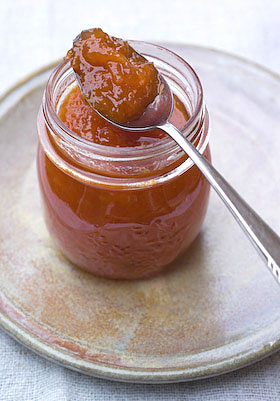
LOST IN TRANSLATION
Friday January 22nd 2010, 6:15 pm
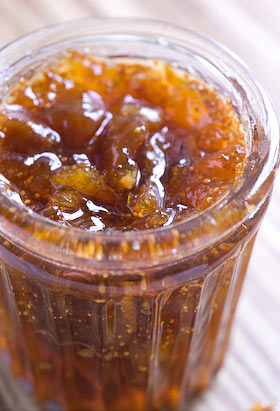
When I was a kid, my friends aunt, who was some sort of food scientist, told me that if you looked at an apple with a bad patch on it, under a microscope, you would see that the badness goes far beyond the brown bit, like spreading mycelium or the roots of a plant. This information was told as a warning, to not think it enough to just cut away the bad part and eat the rest, as what lurks beneath unseen might kill you! As I say, I am recalling a childhood memory here to dramatic effect.
Needless to say, I have always remembered this advice yet always chosen to ignore it. I was brought up to be made of sterner stuff. I follow a scale of food offness of my own design and ‘it hasn’t done me any harm’. I know that there are others whose standards in this regard are much higher than mine and just in case you are by now doubting my credentials and casting aspersions on my forthcoming artisan preserve venture, I do have an official food hygiene certificate.
For 2010, I, along with around 130 others, am taking part in Tigress’ Can Jam Challenge, an idea devised by fellow US based blogger tigressinajam, (see also tigressinapickle). The idea, to choose a different seasonal ingredient each month that can be canned. You can read the challenge outline here. It is all about ‘canning’. In the UK we don’t ‘can’ anyway, we ‘bottle’ and even that is a niche activity. Bottling, in case you don’t know, is a way of preserving food in special glass jars by employing either a hot water bath on the cooker hob or an oven method so the foodstuff is rendered sterile and will thus store in your larder for ever more. Bottling was once popular in the UK, especially during the wartime ‘make do and mend’ era. It went right out of fashion with the advent of the freezer but now seems to be making a come back with the move back to home grown fruit and veg and other eco considerations. As I am keen to know all about it, even though I am generally of the ‘scrape any mould off the top then eat the jam beneath’ school of thought, I intend to embrace the challenge and run with it.
As regular readers will already know, I am a passionate jam, chutney and pickle maker, all activities which in the US seem to come under the canning umbrella but that here somehow don’t. Basically putting your preserves through this canning process will make doubly certain that they will keep and not become contaminated. Canning requires the use of special Kilner jars (or Mason Ball jars in the US) which need new seals every time you use them. These traditional style jars, invented in 1842, have recently been reintroduced and I sell them in my shop. Unlike in the US, you can’t buy complete canning kits here with all the bits and bobs you need to get started, but you can buy some of the equipment, the rest you have to improvise. Anyhow, as the year unfolds I will be able to write about what I discover.
In order to meet the criteria of the challenge, it does mean that any preserves I make must be processed in a hot water bath, or at least I must say they are! Have you lot in the States not heard of the cellophane circle and elastic band method of sealing your jam?
January has a citrus theme. It must be wonderful to pick your ingredient straight from the tree, as some of the other challenge participants are able to do. I had to buy my fruit as none is grown here. Here is my first recipe for the 2010 Tigress’ Can Jam Challenge.
LEMON, FIG & LAVENDER MARMALADE
I am a massive fan of traditional bitter seville orange marmalade and this marmalade is just as tangy and fabulous. The lavender note adds an unusual flavour but isn’t at all over powering or over flowery. A few words first on ingredients; choose lemons that are organic where possible and unwaxed always, for this preserve. I had trouble finding dried figs without a load of gloop surrounding them, as they seem to be sold like this in supermarkets for ready-eating. Eventually I found some really nice dried Lerida figs in the health food shop. Dried lavender can vary a lot. I sell Snowshill lavender, grown in Worcestershire, sold by the scoopful in my shop and it is highly scented and natural. If you can’t find one with a good fresh scent, then please just leave it out; if you use it, it wont bring anything useful to the party.
Makes 1.3kg (3lb)
5 unwaxed lemons, approx 600g (1lb 5oz) plus 1 other lemon
400g (14oz) dried figs
25g (1oz) dried lavender
1kg (2lbs 4oz) sugar
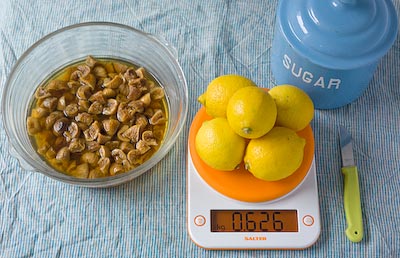
Heat the oven to 180C/ 350F/ Mk 4. Wash the 5 lemons and place in a lidded heat-proof casserole with 650ml (1 1/8pts) water, so the fruits just begin to float. Bring to a simmer, put the lid on and place in the oven to slow cook for 2 1/2 to 3 hours.
Remove the stalks from the figs and chop them into 1cm (3/8in) sized pieces (or smaller or bigger as you like, remembering they swell up as they reconstitute). Place in a preserving pan with 650ml (1 1/8pts) of water and leave them to soak while the lemons are poaching.
Remove the casserole from the oven and lift the lemons carefully with a slotted spoon out of the liquid into a sieve placed over a bowl to catch any drips. Leave them till cool enough to handle then cut each lemon in half and scoop out all the innards, collecting all the pulp and pips in a piece of muslin. Tie the muslin into a bundle and add to the preserving pan along with the poaching liquid and any liquid collected in the bowl. Chop the lemon skins finely into strips and keep on one side. Tie the dried lavender in another piece of muslin to make a bundle and add that also to the pan. Bring to the boil and simmer for 20 minutes.

Take off the heat. Remove the pulp and pip bundle and add the chopped lemon peel as well as the juice from the remaining lemon, passing it through a sieve to remove any pips if necessary. Add the warmed sugar and stir until completely dissolved then heat, bringing the pans contents to a rolling boil and test for a set after about 10 minutes and every 3-5minutes after that until setting point is reached. If you haven’t ever done this before this means that a blob of the syrup on a cold plate will readily form a skin that wrinkles when you push your finger across it. Take the pan off the heat whilst testing.
Turn off the heat, remove the lavender bundle and leave the jam to rest for 15 minutes then stir to distribute the pieces evenly before pouring into hot, clean, sterilised jars. Seal with either waxed paper discs and jam pot lids or the bottle seals and screw tops if intending to hot water process, in which case place the jars in the water bath and process for 10 minutes. For more info about how to hot water process your preserves, refer to the guide here. Leave your jars until cold and don’t forget to label and date them.
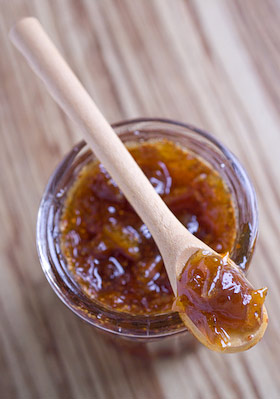
THE VILLAGE SHOW 2009
Sunday August 30th 2009, 3:44 pm

I’m finding it hard to speak about, but yesterday was the Aylburton Horticultural Show and despite my best jam-making efforts, I came away empty handed. Last year at least my jam entry, of crab apple jelly, won a 3rd prize rosette, but this time round I didn’t even manage that. I am trying to be brave about it and keep saying to myself ‘it is the taking part that matters’ bla di bla… Of course that is true and my disappointment does not make the event any less charming.

The trouble is that I have not come away with any idea of what to do differently next time. The laid back nature of our show means that there are seemingly no hard and fast standards to adhere too and no feedback either to learn from. Next year I will be as much in the dark as this, regarding what to enter, but thankfully time is a great healer, as they say….
Last year my crab apple jelly was clear as a bell and a wonderful colour. The taste was nice but no more than you’d expect. Some slightly more unusual preserves seemed to have done well; category 49 (chutney) was won by pear ketchup and the category 46 (jam) by blueberry jam for the second year running, so I surmised that it wasn’t necessary to be totally straight-laced and conventional. Perhaps that is where I went wrong this time? My wild greengage and vanilla jam, with a ‘softish’ set, was perhaps a step too far. Anyhow, I shan’t bang on about it or bring the subject up again, until next year by which time my angst will be a distant memory.

Everyone was saying that this years show was the best ever. There seem to be more entries year on year and the calibre of the produce gets better and better. I always love the funny-looking veg category and the childrens, ‘make veg into a creature’, category. The highlight for me was a potato wearing a bobble cap, which made me laugh out loud, which was a good thing under the circumstances.

The cut flowers were utterly lovely and it was nice to see that traditional show blooms, such as dahlias, have moved with the times, shown in beautiful shades of deep red, sharp orange and shocking pink. My neighbour, Jane, whose Country Bunches I have written about before, of course scooped a first for her mixed bunch, as did her eggs, which she told me could not have been any fresher. She had waited for the eggs to be laid that morning, moments before bringing them along to the village hall. Her attention to detail stood her in good staid and for another year, the ‘eggs for sale’ sign on her front gate can claim the added caveat, ‘award winning’.
It is a joy to photograph the entries and as our village show isn’t so uptight as others I’ve come across, the pictures do, I think, capture the idiosyncratic nature of English village life. You can see more pictures here.
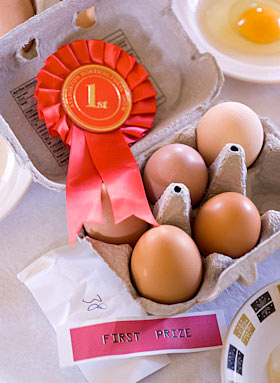
ONE SMALL STEP FOR…THE HUMAN CANNONBALL
Wednesday August 26th 2009, 4:06 pm

Here at Taurus, an annual fire sculpture event has become a much anticipated part of the events calendar. Each summer for the last 10 years, a giant wooden sculpture has been constructed on the front lawn, following a chosen theme and culminating in an evening of ritualistic revellery and the sculpture being set alight. Last year the theme was the Severn Boar, which referred not only to the wild boars that are sighted from time to time in the Forest of Dean but also the famous River Severn tidal wave (spelt Bore) that keen surfers like to ride and that runs close to Taurus. Round here, never a week goes by without a report in the local paper to the effect that someone’s dog has been chased by a boar or someone’s child was chased by a boar or someone was scared out of their skin by a boar.
This years event, Shoot The Moon, is celebrating the 40th anniversary of the moon landing, when man first stepped foot on the moon. I know it may be sounding more than a little ambitious, but the intention is to send someone to walk in Neil Armstrong’s footprints. A sixteen foot high wooden circus cannon is being built as we speak and on Saturday night the foolhardy crew plan to climb inside it, the fuse will be lit, and said crew will be propelled out of the stratosphere.

In true circus style there will be a big circus build up and considerable razamatazz helped by musicians, pyrotechnicians and projectionists. Steve Hyslop is building the sculpture and can add ‘human cannonball’ to his CV. ‘I like the mechanical, rather kitch image of the fat circus cannon. It’s comic rather than threatening, with an element of anarchy,’ says Steve. He and co-conspirator Damon Bramley will thankfully be donning safety gear for their heavenly mission.
All in all, it looks like being a spectacular and memorable evening and everyone is welcome to come along this Saturday 29th August, 6 – 11 pm. You’ll find more information how to find Taurus Crafts here. There is lots of on-site parking (£2 donations welcomed for parking) and you are advised to bring a torch and suitable clothing. For more information phone 01594 844841

YESTERDAYS HAUL
Wednesday August 19th 2009, 9:36 am
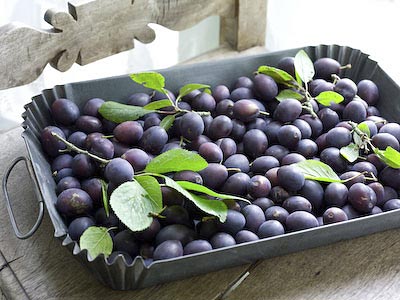
I thought I would post some pictures of the wild damsons I found growing by the roadside in the heart of the forest. I really must remember to keep a set of step ladders in the car for such eventualities, as there is always fruit just out of arms reach that you have to come to terms with giving up on.
When I got home a neighbour had left a bag of plums hanging on the door handle of the front door. I’m not sure who, but I suspect it was Helen and Steve (at the end) who two days ago passed by as I wobbled about on the top of a stone wall, picking more damsons from a tree overhanging the road. Those damsons were growing in someones garden and are larger than the wild ones I found yesterday. I hasten to add I had permission to wobble about on their wall. Helen and Steve asked me if I was scrumping (is it called scrumping for plums, or does that term only apply to apple picking?). I think I may be gaining a reputation.
I am thrilled with my damson crop as they are just about my favourite fruit for preserving and don’t need to be used in any oity-toity combination with anything. They are just perfect on their own.









